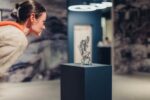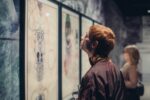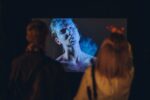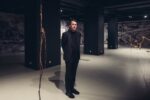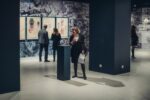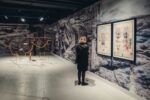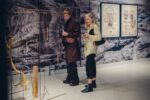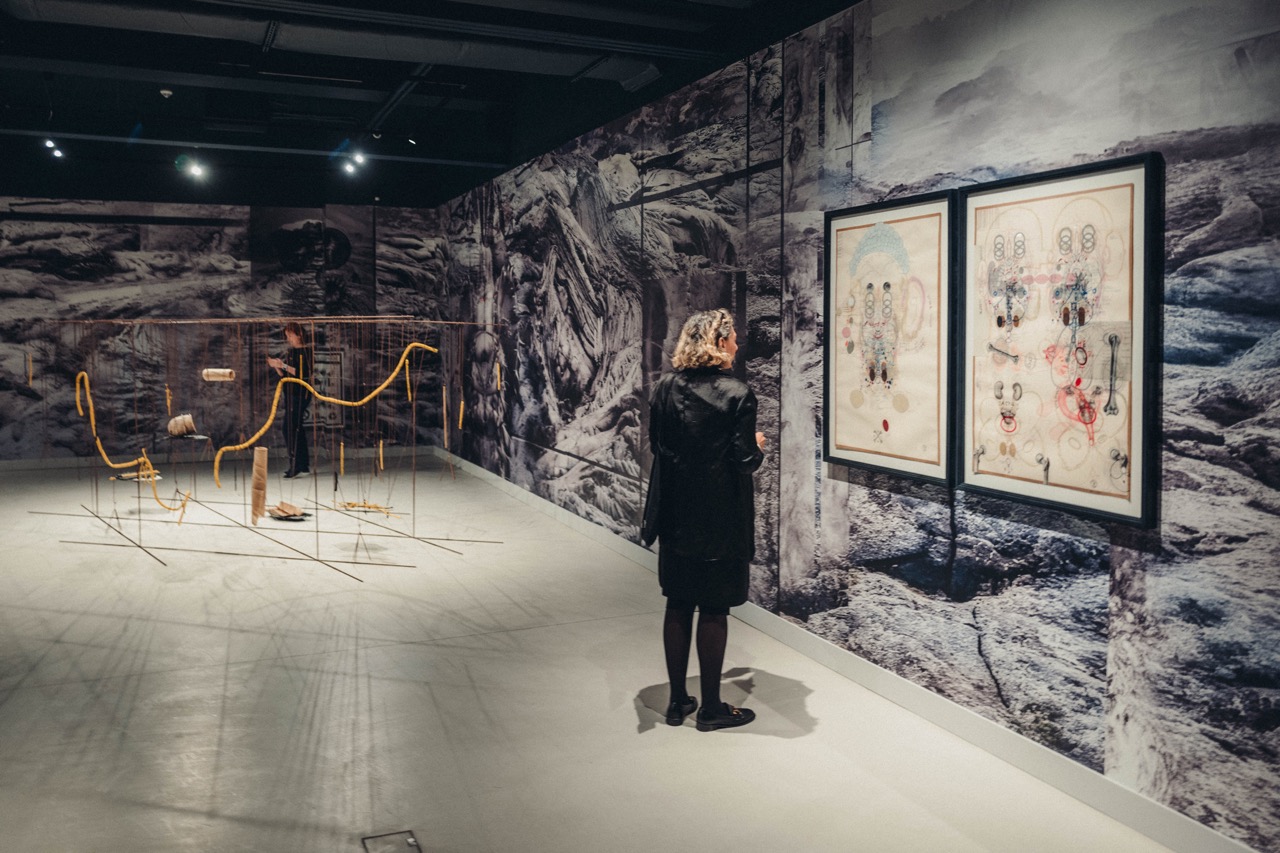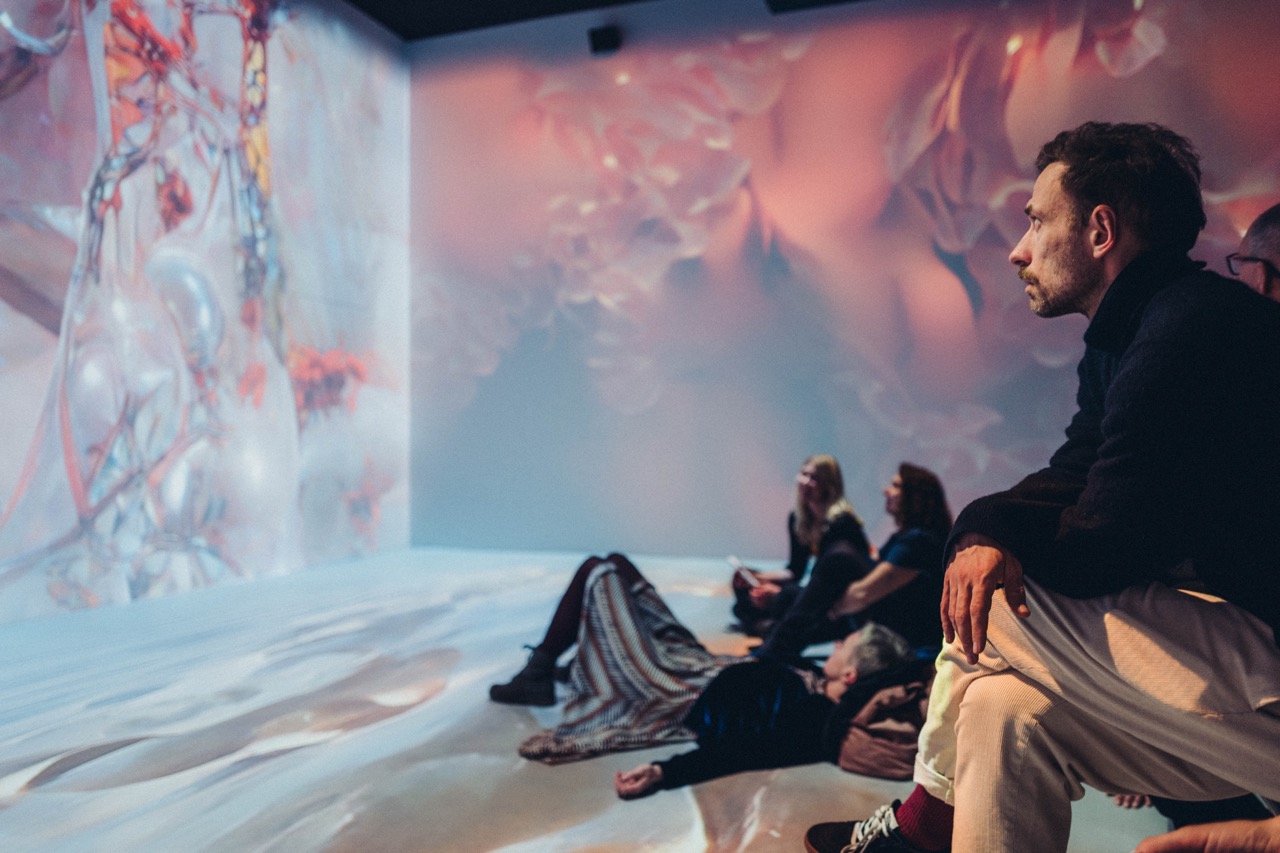Program
KAF
March 14 – June 1, 2025
featuring Szilvia Bolla (HU), Joey Holder (UK), Denisa Lehocká (SK), Ursula Mayer (AT-UK), Luboš Plný (CZ), Iza Tarasewicz (PL),
curated by Boris Ondreička (SK)
…and Majnun, in his love for Leila, is obsessed by her beauty, even if she does not seem beautiful to others. ‘‘To see her beauty’’, he declares, ‘‘you must borrow my eyes’’…
The Neurobiology of Love pp. 2579
Every weekend (Saturday and Sunday) at 5:00 PM, we invite you to a guided tour of the exhibitions, included in the gallery ticket price.
Main motivation of The Neurobiology of Love rises out of observation of intertwinement of artistic and scientific ways of imagining and its further imaging, materialization of “subject”. Sometimes it is surprising (even for scientists themselves) how precisely artists portray certain phenomena even from other points of departure and methodology, allowing intuitive[1] and/or automatic, subconscious forces to guide their creative endeavours. The Neurobiology of Love meditates around personal viewing[2], tacit knowing[3] and chances of embodiment of “undisplayable” / “unspeakable”.
Following Semir Zeki’s pioneering study of neuroaesthetics[4], The Neurobiology of Love understands production (in-out) and consumption (out-in) of “undisplayable” in the wider net of triggers and consequent processes (of postproduction and distribution). It traces myriads of frequencies of neurosis of creative urge[5] (and self-expression-drive) rising in a vertigo of turbulent times we live in. Neurosis of internet of everything incorporates itself in artistic cosmos of curves, synapses and hatchings, mycelia of drawing, pirouettes of performative act.
The Neurobiology of Love focuses on individual psychological which is influenced by (out-in) and influences (in-out) collective political. It does not matter if consciously, conceptually, strategically, or unconsciously, “spiritually”, poetically, metaphorically, spontaneously¾it does anyhow.
Even The Neurobiology of Love focuses on individual, it understands (micro) individual as unbreakably related (out-in-out) to the other/ness, collectiveness, transindividuality (from passive contagion to active imitation)[6], (macro) globality.
Even The Neurobiology of Love is concentrated to psychological (and mental), it understands it in unbreakable context of somatic. Doing art is a psychosomatic delivery per se. There is something trivial we must remember: eyes do not see anything, they just look, brain sees.
The sub-centre of interest of this project is love¾artists who do art from love (as certainly essential activity of their lives), artists who distribute vibes of empathy, tolerance, solidarity, love as an expression of both intuitive, impulsive affection (according to a particular provoking effect), inclination and systemic, effective engagement. Inclination / affection leads us to crucial decisions obviously. Even democratic elections are dominantly result of personal aesthetical judgment and symbolical action. Neuro-aesthetics plays key-role to understand that dynamics there but art as well.
Body (even reinterpreted both linguistically, philosophically / ontologically… as well as physically ad absurdum) is still here. It is a battleground where Eros remains in chronical dialogue with Thanatos[7]. Love is a knot of synchronous romantic, symbolical, imaginary, abstract as well as corporal, rudimental, erotic, maternal, real… natural and cultural[8]. Love might be “unspeakable”¾but art carries high competence in experimental elaboration of the insight and postproduction of inner (image)[9] to outside. Intersubjective love addresses questioning of the other / otherness[10]. Anyhow, the first other, the initial alien to myself is me. To both maternal and romantic love we can add metabolism of artistic love / creative urge as love.
As Zeki perfectly describes in his essential study, “human attachment seems to employ a push–pull mechanism that overcomes social distance by deactivating networks used for critical social assessment and negative emotions, while it bonds individuals through the involvement of the reward circuitry, explaining the power of love to motivate and exhilarate”. Creation of art as well combines mechanisms of deactivating criticality and pragmaticity to activate free flow from subconsciousness. Real or realistic of arts is not necessarrily mimetic, imitating external objects. Realistic can be visualization of “invisible, immaterial…” feelings. Might be we can say it is not a form of creativity indeed, because artist does not create anything new but describes what is already “there”. Might be we can call it “meta-mimesis”[11].
Speaking about invisible, which does not provide any proof that it is “there”, sometimes it is just transparent; and that’s also why “transparency is a form of darkness” as gloriously described by Thomas Metzinger[12].
Speaking about intuition, it is very much related to revelation of something “seen” from in- (“in, on”) + tueor (“to look, watch, guard, see, observe”).
Messages what art articulates then to the outside from “there” can be very precise in its own character, and precious. Art’s capability to go beyond explicit language or to dive back to abysses of biosemiotics[13], to create new languages, not to be limited to any (mirage of) consistency… extremely extents relevant possibilities of description and further communication even of some “unknown”.
The Neurobiology of Love offers insight to selection of artists who work with their individual relation to corporality, humanity, culture, politics and nature in rather implicit and associative way.
The Neurobiology of Love offers the perceiving of works present here behind and beyond poetic to more visceral reading which is no contradiction. Poetic is carnal as well and vice-versa carnal is poetic. Motivation (and crucial motivity as well) of art making is primarily bodily.
Each artist in The Neurobiology of Love follows diverse creative backgrounds, routes and use of media. To following descriptions of each position, we should then always include “amongst many other things”.
Szilvia Bolla does “psychosomatic photographs” which transfer an image to other dimensions and media. These objects which rise out of dealing with complexity of psychical puzzles are following consideration about some healing effects. Reading the “nature” of Bolla’s “flowers” which grow on gut-brain axis[14] and bloom in the gallery space, to fundamental (certainly abiogenetic[15]) trinity of mineral-vegetable-animal one can add -machine.
Joey Holder forms comprehensive cosmological environments of unknown or we can even claim mystical. Her mostly digitally rendered works are hypotheses which test chances of both scientific, technological, magical, philosophical, artistic, human and machine chances and limitations. Here, her work creates all-encompassing biotope of the entire The Neurobiology of Love.
Denisa Lehocká names her ongoing creative activity “breathing”. “Breathing” means that the process of artistic creativity is organic and unbreakable part of her every-day existence. Her spatial intuitive assemblages deal with ways of very intimate personal becoming stretched by cultural and social bonds. Both art and subsistence are hybrid. There is no border between real and abstract here. Similarly to Bolla, pharmacological aspect is important for her practice.
Ursula Mayer produces films based on montage, objects and installations. Even when screening her single film, it always swallows the space and becomes installation of its own. Here, her awarded film Gonda, which is certain “geology of self”, where one traces material sympathies and antipathies in the frame of biopolitics of posthuman, distributes moving image, light and colour as well as provides some soundtrack of the entire The Neurobiology of Love.
Luboš Plný makes “anatomical self-portraits” which are not only surficial but enlighten the deepest darkness of his entire body. His “anatomy” is an image of not only physiology but also apparent energetical radiations and psychic associations. Mind is a body. Body is a mind. His drawings include variety of crude biological material (even ashes of his parents), and always detailed description of time and particular aspects of production.
Iza Tarasewicz constructs modular DNA-like habitats (forests or distributed bodies) which give “life” to other “things”. Those structures which cross borders between interior and exterior (we can say that are “transparent”) deliberate further transformation of those “things” and at the same time it is flexible enough to allow those things to change themselves. Her works question forms of living / survival, co-existence, adaptation and one can even say world-making.
[1] Intuition is the ability to acquire knowledge, without recourse to conscious reasoning or needing an explanation.
[2] as in discoveries of what later was coined as “entoptic phenomenon” (David Lewis-Williams, 2002, following Gerardo Reichel-Dolmatoff, 1975) which its discoverer Jan Evangelista Purkyně described as “subjective viewing” (1823)
[3] as in Michael Polanyi’s Personal Knowledge: Towards a Post-Critical Philosophy (1958, Routledge & Keegan Paul)
[4] as in Semir Zeki‘s Inner Vision: an exploration of art and the brain (1999, Oxford University Press)
[5] as in Otto Rank‘s pioneering Kunst und Künstler: Studien zur Genese und Entwicklung des Schaffensdranges (1932, Art and Artist: Creative Urge and Personality Development, Alfred A. Knopf)
[6] in Gilbert Simondon’s sense
[7] as in the concept of “der Todestrieb” of Sigmund Freud (1920) after Sabine Spielrein (1912)
[8] extending diagrammatic structures of Jacques Lacan and others
[9] as well as in Eric Kandel’s The Age of Insight: The Quest to Understand the Unconscious in Art, Mind, and Brain, from Vienna 1900 to the Present (2012, Random House)
[10] in Maurice Merleau-Pontyian sense
[11] as elaborated also in Metamimesis: Imitation in Goethe’s Wilhelm Meisters Lehrjahre and Early German Romanticism by Mattias Pirholt, Camden House, 2012
[12] Inicially in his Phenomenal transparency and cognitive self-reference vo Phenomenology and the Cognitive Sciences, #2, Springer; pp. 353¾393. Followed by briliant interview with Ray Brassier A Special Form of Darkness, Arika, Edinburgh, 2012 (online).
[13] Biosemiotics is a field of semiotics and biology that studies the prelinguistic meaning-making, biological interpretation processes, production of signs and codes and communication processes in the biological realm.
[14] The gut–brain axis is the two-way biochemical signaling that takes place between the gastrointestinal tract and the central nervous system.
[15] Abiogenesis is the natural process by which life arises from non-living matter, such as simple organic compounds.
Curator
Boris Ondreička (*1969) is a freelance curator and occasional artist based in Bratislave, SK and Vienna, AT. He is former artistic director viennacontemporary fair (Vienna, AT), director of tranzit_sk (Bratislava, SK), co-curator of Class of Interpretation (Prague, CZ) a curator at TBA21 (Vienna, AT). Amongst many he co/curated Rare Earth, Olafur Eliasson „Green light—An Artistic Workshop“, Ephemeropteræ, Supper Club (all at TBA21), The Question of Will, OSF (Bratislava), Empire of the Senseless, Meetfactory (Prague); Manifesta 8 (Murcia, Cartagena, ES), Being The Future, Palast der Republik (Berlin)… His artistic projects were part of Bergen Assembly 2019, Manifesta 2, Venice- (Roma and Czecho-slovak pavilions), Tai-Pei-, Athens-, Kyiv-, Jakarta- biennales; MoMA PS1 and New Museum (NYC), BAK (Utrecht), W139 (Amsterdam), Smak (Gent), Tramway (Glasgow), Fondazione Sandretto re Rebaudengo (Turin), Le Plateau, Air de Paris (Paris), Badischer Kunstverein (Karslruhe), Würtembergischer Kunstverein (Stuttgart), HMKV (Dortmund); Kiasma (Helsinki); HKW (Berlin); Steirische Herbst (Graz); Secession, Mumok, Kunsthalle, Belvedere (Vienna)… Amongst many, his texts were published in Sogni / Dreams (Castelvecchi, 2003, Francesco Bonami and Has Ulrich Obrist eds); Now What? Artists Write! (Revolver, 2004, Mark Kremer, Maria Hlavajova, and Annie Fletcher eds.); One Second | Out of Time (Revolver, 2004); The Next Documenta Should Be Curated By An Artist (e-flux and Revolver, 2004, Jens Hoffmann eds.); Hi! Lo. (JRP Ringier, 2011); Lecture Performance (Revolver, 2009); Studio Olafur Eliasson: Open House, TYT (Take Your Time) (Walther König, 2017); Spevník / Songbook (Brak, 2018). He lectured at CalArts (Los Angeles), Royal College of Arts (London), DAI (Enschede and Arnhem), ACAF (Alexandria), CUNY Brooklyn College and New Center for Reasearch & Practice (both NYC), HKW (Berlin), De Appel (Amsterdam), and at academies in Bratislava, Brno, Prague, Vienna, Linz, Budapest…
Artists
Szilvia Bolla, Rivotril Flowers Fall II (Serotonergic Swirl)
Szilvia Bolla (b. 1992, Hungary) is an artist working between Budapest, Hungary and The Hague, The Netherlands. She explores the personal, social, and cultural dimensions of depression, transgenerational trauma and memory through sculpture and photography evoking bodies shaped by biopolitics. Her work has been included in exhibitions at the Stefan Gierowski Foundation in Warsaw, Gossamer Fog, Plicnik Space Initiative and Victoria & Albert Museum in London, VUNU Gallery in Košice, Berlínskej Model in Prague, Semester 9 in Amsterdam, Trafó Gallery, Art Quarter Budapest and Glassyard Gallery in Budapest, among other venues. She has been an artist in residence at Cité Internationale des Arts, Paris, International Studio & Curatorial Program, New York City, and Akademie Schloss Solitude, Stuttgart. She’s part of the artist duo Alagya.
Joey Holder, The Evolution of the Spermalege
Joey Holder is an artist and researcher whose work raises philosophical questions of our universe and things yet unknown across science, technology, and human-machine-animal interactions. She creates immersive, multimedia ‘worlds’ by conversing with experts across fields including marine biology, genetic research, and behavioural psychology, exploring themes ranging from deep-sea lifeforms, speculative evolution, Magick, non-human time and aliens.
Her research investigates how our belief systems deeply shape how we perceive, interact with, and understand the environment. These systems, which include mythological, cultural, political, and philosophical frameworks, influence our perceptions of nature, our relationship towards it (and therefore each other), and the value we place on environmental protection.
She is currently a PhD Candidate at Birmingham City University where she is exploring how participatory, transdisciplinary artworks can reshape our understanding of time and life through the lens of resurrection ecology and regeneration. Through a convergence of art, ecology and anthropology, her research thesis aims to transcend linear and predictive narratives about the environment, proposing new ways of imagining life’s trajectory and challenging existing conventions of evolution and adaptation.
Holder has exhibited widely internationally, including the Harvard Museum of Natural History,
Design Museum London, the Sydney, Athens, Ljubljana, Wuhan and Moscow Biennales, and Transmediale in Berlin. She also directs SPUR, an online platform supporting digital art, and Chaos Magic, an arts project space in Nottingham.
In 2021 she was named in Apollo Magazine’s 40 Under 40 for her cutting-edge contributions to the intersection of art and technology. She has been featured in The New York Times, The Guardian, Frieze magazine, Artforum, Art Monthly, Flash Art, Studio International, Dazed, VICE and BOMB.
Denisa Lehocká, Untitled, Untitled, Untitnlrd
Denisa Lehocká developed a “poetics of conciseness” in her work, which seems as light as it is ephemeral and deals with the manifold and opaque relationships between objects and subjects, between the real and the imaginary.
Despite the haptic appearance and playfulness of her objects, drawings, paintings, and sculptures, her works are bound to an analytical principle and hold a balance between abstraction and narrative. Lehocká’s object constellations are the sediment of a tedious artistic production process, which begins initially with a concrete method of relating to the object and then proceeds to work away from it by exploring the infinite combinability of graphic elements. With these anthropomorphic bodies, she develops spatial sculptural installations (“spatial collages,” as she calls them), with special attention to the way they inhabit the given space. Her works are levitating materializations of the so-called immaterial and representations of deep subjectivity and the ephemeral.
Denisa Lehocká (1971*, lives and works in Bratislava). Her works are in collections such as Erste Bank Group Collection, Vienna, Austria; EVN Collection, Vienna, Austria; Sammlung Friedrichshof, Vienna, Austria; European Investment Bank, Luxembourg, Luxembourg; Fiorucci Art Trust, Monaco, Monaco and London, UK; Societé Generale, Paris, France; The Daniel and Florence Guerlain Collection, Les Mesnuls, France; Slovak National Gallery, Bratislava, Slovakia.
Luboš Plný, +22685, +22547, +21911, +22090, +22427, +21264
Luboš Plný (*November 4, 1961, Česká Lípa) is a Czech painter and conceptual artist who is represented in a number of important foreign and domestic collections. In 2017, he was the only Czech artist to be selected for the international exhibition Viva Arte Viva! at the 57th Venice Biennale of Art. In 2021, he won the first prize in the drawing category at the contemporary art Biennial in Skopje, Macedonia. He lives and works in Prague.
In the late 1980s, Plný attempted to get accepted to the Academy of Fine Arts in Prague twice, but was unsuccessful. In 1989, he was employed there as a model in figure drawing
courses with the aim of obtaining the previously non-existent title of "Academic Model". At the end of his performance, he collected enough documents to cover an entire diploma thesis. In 2000, the Rector of the Academy of Fine Arts, Jiří T. Kotalík, solemnly awarded him the title. Since then, he has used the “academic model” stamp as his signature.
At the same time, he has continued to devote himself to his own artistic creation – drawing,
painting, conceptual art and performances.
In his works, Plný deals mainly with the human body, its functioning, limits and finitude.
Most of his works can be considered “anatomical self-portraits”, which skirt the boundaries between drawing, painting, conceptual art, and scientific projects. He combines coloured ink drawings with acrylic painting and collage, and complements them with authentic organic elements.
Part of each drawing by Luboš Plný are detailed written records, which are also his diary. He marks the beginning and end of his work on each drawing with the number of days he has lived until that date, as well as with the symbol of an asterisk and a cross. He also systematically records other individual time data, such as pauses in drawing.
In addition to drawings, projects are important to Plný. He himself calls the “Academic Model” project the most significant (due to its complexity and duration). However, alongside it, one cannot overlook works such as Mother, Father, Gravedigger, The Stowaway, his Navel Diaries, or Stitching and Re-Construction.
Another interesting chapter of Plný's life is the production of so-called Erotic Toys – three-dimensional assemblages with erotic themes.
It is also necessary to mention that Plný consistently documents his life journey in a diary, in
which he writes down a daily list of activities and personal information, which he supplements with period press clippings or photographs.
Iza Tarasewicz, The Means, The Milieu I
Iza Tarasewicz was born in 1981 in Białystok, Poland. In 2008, she graduated from the Faculty of Sculpture and Spatial Activities at the Academy of Fine Arts in Poznań. Her sculptural installations take the form of modular, flexible, mobile, and reconfigurable systems that combine raw and modest functionalism with the formal logic found in nature, scientific experiments, and diagrams—figures of thought and relational charts that systematize knowledge and data while abstractly describing the interactions of phenomena.
The artist draws inspiration from the atomism of classical Greek philosophy, as well as from 20th-century quantum physics and chaos theory. Her sculptures and ensembles of objects, which can be assembled into installations, generate energy-filled systems composed of hard-to-recognize organic and inorganic materials.
She lives and works in Kolonia Koplany, Poland. Tarasewicz was awarded the Bayerischen Kunstförderpreise in the field of fine arts in 2019. In 2015, she received the Spojrzenia award from the Deutsche Bank Foundation, a leading prize for young Polish artists co-organized by Zachęta – National Gallery of Art in Warsaw. In 2013, she was nominated for the Paszport Polityki award in the fine arts category.
In 2016, Tarasewicz participated in the 32nd Bienal de São Paulo, the 5th Moscow International Biennale for Young Art, and the 11th Gwangju Biennale (South Korea). In 2018, she represented Poland at the 16th Venice Architecture Biennale in collaboration with the CENTRALA group.
Her works have been exhibited in numerous solo and group exhibitions in Poland and abroad, including at:
- Ludwig Museum, Budapest (2020)
- Kunsthaus, Dresden (2020)
- Pori Art Museum, Finland (2019)
- Museum of Contemporary Art, Zagreb (2018)
- Contemporary Art Center, Vilnius (2018)
- Zachęta – National Gallery of Art, Warsaw (2018)
- KUMU Art Museum, Tallinn (2017)
- Arsenal Gallery, Białystok (2017)
- Nogueras Blanchard, Madrid (2017)
- Futura, Prague (2016)
- European Central Bank, Frankfurt (2016)
- Center for Contemporary Art, Toruń (2016)
- Ujazdowski Castle Centre for Contemporary Art, Warsaw (2015)
- Kunsthalle Bratislava (2015)
- Galleria Civica di Modena, Modena (2015)
- Polnisches Institut, Berlin (2014)
- Xawery Dunikowski Museum of Sculpture, Królikarnia, Warsaw (2013)
Her monumental installation Once Information Has Passed Into Protein, commissioned by Art Collection Telekom, is periodically displayed at the Museum of Fine Arts in Leipzig.


